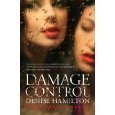Denise Hamilton Guest Blogs
Do you think you could turn your passion into a career? Friend of the Tarts Denise Hamilton has done just that--twice! And she smells sooooooooo good while doing both.
By Denise Hamilton 
Last year, I went back to journalism.
I became the perfume columnist for the Los Angeles Times.
It's a once-a-month gig, which I figured was do-able for a dame who writes crime novels full-time.
Besides, I needed some justification for the bottles colonizing my bureau, bedroom closet and bathroom shelves.
How many bottles? 
*Cough* I plead the 5th Amendment.
The idea for a column came last year while chatting with the L.A. Times Magazine editor, a savvy lady who shares my obsession.
"You know," I told her between sips of cappuccino, " the NY Times has a perfume columnist. They do reviews and profile the 'noses' who create perfumes and they write about it seriously as an art form. Which I love! The classic French perfumes, and many of the artisanal ones made by niche firms these days are fantastic. Here, smell this."
With that, I reached into a tote bag and brought out a half-dozen bottles from vintage Shalimar extrait to Donna Karan's spicy oud scent Chaos to Andy Tauer's "L'Air du Desert Marocain," which smells like all the good spicy things about the North African desert, without the camel dung and camel driver BO.
Editor, taking bite of croissant and spritzing carefully: "Hmmm. Would you consider writing this column for us?"
After settling on a monthly fee, we discussed the format. It would be for the general reader, not the perfume insider.
The first column would introduce me and describe how I fell down the rabbit hole into perfume obsession, starting with a French/Russian mom who had plenty of Chanel, Yves St. Laurence, Rochas and Dior that I plundered as a child.
Subsequent columns have featured Q&As with acclaimed noses like Olivia Giacobetti (she created L'Artisan's Premier Figuer, the first true fig scent); the versatile orange note in perfumerie (neroli, orange blossom, candied orange, petitgrain, etc) and why perfumers use civet, musks and cumin notes that hint at sweat, sex and unwashed skin.
The answer: Despite our myriad disinfectants, deodorizers and soaps, humans are attracted – if only subliminally - to musky animal odors. So in the same way that bakers add a pinch of salt to sweets, perfumers add a little soiled sheets darkness.
Consider Jacques Guerlain, who dreamed up such classics as Apres L'Ondee Mitsuko, L'Heure Bleue, Shalimar and so many others. Guerlain once said that he included the smell of his mistress's backside in each perfume he created. And as Chandler Burr so helpfully elaborates in his wonderful book "The Perfect Scent," Guerlain "was referring to all three holes."
You'll have to figure that one out for yourself, my friends.
So now, when I need a break from stabbing, strangling, bludgeoning and shooting people, I put on some perfume and get cracking with the next column.
I get a lot of complimentary samples from perfume firms, but I also buy a lot of bottles myself, especially rare, vintage and discontinued ones, as I'm always trying to expand my historical knowledge about the art form.
I'm also planning a column about perfumers who use all natural ingredients, eschewing the aromachemicals that make up the majority of ingredients in many department store perfumes today. For those with perfume allergies, the naturals, made in small batches, with organic natural ingredients, might provide a viable option.
And in my September column, I've found a way to combine my love of crime fiction and perfume by writing about how mystery authors from the 1920s to the present have used perfume and smell as a clue to whodunit. These include Dame Agatha Christie, SS. Van Dine, Ruth Rendell and…moi.
The protagonist of my new book Damage Control is a budding perfumista, a skill that will come in handy by the book's end as she seeks a clue to identify the killer.
Meanwhile . . . What's your favorite perfume?
Denise Hamilton's crime novels have been finalists for the Edgar, Anthony, Macavity and Willa Cather awards. She also edited Los Angeles Noir and Los Angeles Noir 2: The Classics, which spent two months on bestseller lists, won the Edgar Award for "Best Short Story" and the Southern California Independent Booksellers' award for "Best Mystery of the Year."
Denise's new novel, Damage Control, will be published by Scribner on September 6, 2011 and has already received a starred review in Publishers Weekly (excellent), a rave advance from Kirkus (In a novel that marries celebrity culture, surf noir and the bonds of friendship, Hamilton is at the top of her game) and kudos from James Ellroy (A superb psychological thriller).




